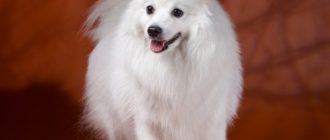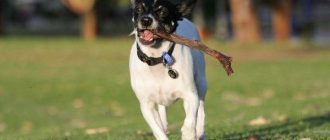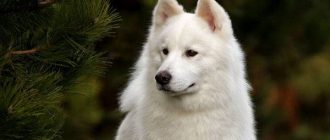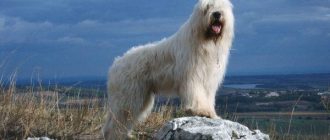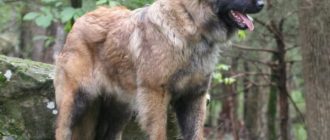Assessment of breed characteristics
Contents
| Adaptability Definition of how easy a dog is. can adapt to changes in life. |  |
| Shedding Level Level and frequency of hair loss in animal. |  |
| Level of tenderness Level and amount of tenderness and affection that the dog gives back in return for attention to itself. |  |
| Need for Exercise Daily Activity Level dogs. |  |
| Social need Required number of dog contacts with other animals as well as people. |  |
| Housing ratio Factor that determines the level of noise and other inconvenience that the dog can deliver to the owners in the ratio the size of the apartment to the size of the dog. |  |
| Grooming Number of bathing, combing, as well as necessary number of professional grooming sessions required the dog. |  |
| Friendliness in an unfamiliar environment society with strangers or in an unfamiliar environment. |  |
| The tendency to bark The tendency to bark and its frequency and volume. |  |
| Health Issues Potential Health Status dogs. |  |
| Territorial tendency of the dog to protect his house, yard or even a car owner. |  |
| Cat friendliness A trend towards cat tolerance and reduced manifestation of hunting instincts. |  |
| Intelligence Dog’s ability to think and solve emerging difficulties (not to be confused with learning!). |  |
| Education and training Level of difficulty in training a dog perform certain actions. |  |
| Friendliness for children Factor determining how much the dog friendly to children, whether she likes to play with them and endure some children’s pranks. |  |
| Game activity The concept is determined by its very name, and, usually found in almost all dogs. |  |
| Observability Dog’s ability to detect presence a stranger in his territory. |  |
| Friendliness for other dogs Dog’s tendency to find common language with other relatives. |  |
Brief description of the breed
This little dog can be attributed to toy dogs (decorative breeds), but by nature, it’s really real terrier. Active, smart, loving games, while getting along well with cats, he will be a real joy for the whole seven – it’s all about Yorkshire Terrier. Distinctive feature of this breed is a beautiful coat, even when trimmed!
Advantages of the Yorkshire Terrier
- Very cute, cheerful;
- Agile and quick-witted;
- Very attached to the owner;
- Suitable for older people;
- Adapts to any home;
- Does not need long walks;
- Very playful;
- Can participate in dog competitions, for example, in dog racing.
Cons of the Yorkshire Terrier
- Loves to bark;
- May tire the whole family;
- It’s hard enough to train;
- Needs careful care;
- It shows a sense of ownership and jealousy of the owner;
- Sometimes there may be problems with the toilet.
Yorkshire terriers have long been faithful companions of the rich people and older women who cannot imagine their lives without a doorman in the house and without active participation in various charity events. The popularity of this dog is constantly growing, it is connected, as already mentioned, with a beautiful, soft, silky hair and insanely expressive eyes dogs. Yorkshire Terrier is very vigilant, he belongs to the group easily trained dogs. This is an insanely curious dog. All his qualities inherent in dogs of large breeds. The weight of the dog is usually not exceeds 3.5 kilograms, so it is often associated with pocket rocks. Despite their small size, Yorkies like and other dogs require attention and love. He will be happy take long walks, and if necessary it can become an excellent watchman. The rather bold character of this dog is not is a positive feature that would allow to contain dog in families with children. In addition, its small size is also are the reason that yorks shouldn’t be contain if you have small children. During york games can to overdo it and bite, including the child. In communication with the Yorkshire Terrier is quite calm and not shows a special temper. Another hallmark of the glamorous Doggie is the love of barking. If Yorkie starts barking, sometimes it’s hard enough to stop.
Appearance
The Yorkshire Terrier is a small, elegant dog, majestic and with luxurious hair falling down on both sides torso, parting extends from the nose to the tip of the tail. The body is short, compact, the back is straight, the ribs are moderately stand out, the lumbar region is muscular. Forelimbs straight, with obliquely set shoulder blades. Hind limbs They look straight, and when viewed from the side, they are slightly bent. The paws are round, claws of black color. The tail is docked, medium length, fully covered with wool. If the tail is not docked, it holds a little higher ridge line, straight, as far as possible, all covered with hair. Small head, set on a long neck, jaw not very long, black nose. The upper and lower jaw are the same lengths. The teeth are even with a dense scissor bite, which means that in closed form, the incisors of the upper jaw fit tightly in front of incisors of the lower jaw. Eyes are medium sized, dark, shiny, with an intelligent and lively expression. Opposite opposite friend friend, can not be bulging. The eyelid is painted in dark color. The ears small, V-shaped, set high, not widely spaced, erect, covered with short, smooth hair.
Wool and color
Wool is the hallmark of this small and incredibly attractive doggies. Yorkshire terrier long, smooth, silky coat, which is smoothly characteristic falls off on both sides of the body, in addition, completely devoid of undercoat. The hairy covering the face is also sufficient long and harmoniously combined with the overall look. Adult dogs who attend exhibitions tend to have long hair, which goes down to its paws. From the side it looks as if running york on wheels. Yorkshire terrier color: steel blue, resembles a cloak that covers the body from the back of the head and before the tail. Colors may not be present on this part. yellow gold or brown. On the rest of the body the wool is dyed in rich gold, which rises to the very neck. Not a single one mixes with the red-gold color on the head. dark or gray hair, the so-called scorched color. Hair has especially saturated color at the root, a little lighter in the middle, and at the ends the lightest. Dogs are born in black-burning color and only with time does the color meet breed standards. Yorkshire Terrier is easy, no need to own any special skills, such as when cutting a poodle or bedlington terrier. However, caring for York should be systematic. The pet should be brushed regularly and at least every ten days, bathe carefully with a special shampoo designed for the care of dogs with long hair. It is also advisable to use balms after bathing, otherwise in case the combing process will be very difficult, a lot will appear knots and shredded wool. If your favorite is not takes part in exhibitions, it is better to contact the nearest salon for dogs and arrange for him a more interesting, short haircut.
Yorkshire Terrier photo:
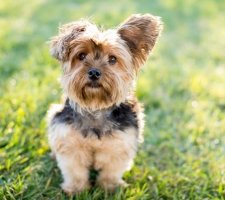

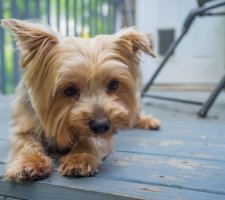


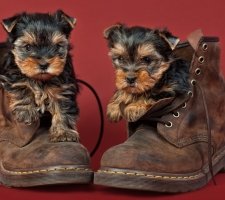
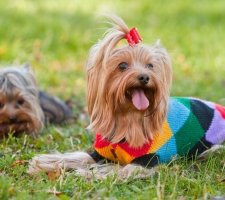

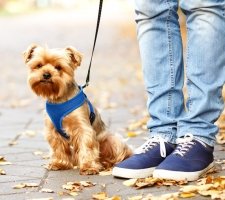 Photo of Yorkshire Terrier dogs |
Photo of Yorkshire Terrier dogs |
Origin history
Life likes to surprise: for example, the appearance of one of the most luxurious breeds contributed to poverty and extraordinarily difficult economic situation. The industrial revolution in 1860-1870 years forced thousands of workers to leave work in the Scottish weaving factory and look for work elsewhere. Work found in Yorkshire, in England, where at that time the textile industry was still profitable. After moving to a new place, workers were taken away from themselves and their dogs, which they greatly appreciated and used to home protection, rodent capture and hunting. Of course, the possibilities they didn’t have a large dog, and York had its own, important advantages – worked a lot, but ate, at the same time, not enough. dogs began to cross with Clydesdale Terriers, dogs, whose size did not exceed the size of a ferret, their fur was short and soft, and the color is black burning. Also the progenitors of modern paisley terrier dogs, also similar to sky-terriers, they differed in that their coat was very silky and completely painted in a steel blue tint on head and torso, and on the legs had a light golden color. From The Yorkshire Terrier inherited their fine coat. Not it is possible that there was also a Manchester terrier, dandy-dinmont Terrier, sky terrier and lapdog. And York, despite the changes in in its appearance, everyone also hunted pests that planted in cotton yarn, as well as rats in mines. Always followed his owner and was perfect for this, because that was small and could fit everywhere, even in the smallest the corner. Soon the hunt for rats in the English became a sport, before Yorkshire Terrier faced a difficult task: for a certain length of time strangle as many rats as possible. In this he too turned out to be extremely useful, because the cost of the dog, which won, increased, and after she left competition, profitable to its owners, continuing its The Yorkshire Terrier became truly popular only when he first appeared at a dog show. In 1874 Frank Pierce de Feversam introduced the Yorkshire Terrier in the first clan book, and this date is considered the beginning of the development of the breed. First dog which was registered, was born in 1865, by knitting mother and son, Huddersfield Ben became the first representative of his breed, it looked perfect, thanks to the fact that it was obtained by Crossing close relatives. He was good at everything: getting prizes at exhibitions and, at the same time, showed perfect results in rat strangulation competitions. Left behind numerous and beautiful offspring, to whom all his best were transmitted The fact that the Yorkshire Terrier began to appear on exhibitions, did not escape the attention of senior ladies. Exactly therefore, very soon breeders began to breed dogs suitable to the taste of potential aristocratic buyers. Tried to get each time an ever smaller dog with perhaps more long and lush coat. As a result of constant crossbreeding, York’s long torso gradually gained a square shape and weight decreased from 8 kg to 3 kg. In 1870, the dog began to be called Yorkshire Terrier, and in 1898 the first representative of the breed. Nowadays, the breed Yorkshire Terrier practically known to everyone and every day she has everything more fans. The very first Yorkshire Terrier appeared on Russian territory in 1971. He was presented to ballerina O. Lepeshinskaya, at about the same time some representatives of this breed in large cities. In the early 90s in Mytishchi was founded the first in the country nursery Yorks, which were dogs were delivered from Spain and England, and then from France for future breeding. Now in the Russian breed club registered more than 75 nurseries.
Yorkshire Terrier Character
The character of the Yorkshire Terriers depends on how they are raised. Some are active and have immense energy, courage, and others, on the contrary, are quiet, calm and docile. When they talk about Yorkies, then immediately comes to mind the small tame dogs with which noble ladies like to go on the promenade. These little miracles – Dogs love attention to themselves and do not like to be left in loneliness. That is why terriers always follow their the owner. These dogs are great companions, they make up a good company for the elderly, as well as those who have a lot of free time to concentrate on pet breeding. The breed is so popular that many dog breeders are considered obligated to have such a wonderful animal. Yorkies, on the one hand, are very shy, and on the other, very welcoming and friendly. However, they can be different. Respond to strangers or your guests. common feature the character of all Yorks: independence, high intelligence, determination and tenderness. Like for small dogs, Yorkshire terriers are too independent. They can set their own rules, so do not go about your pet. IN to some extent, the independence of the yorks keeps up with their courage. The fact is that these small animals can be enough bold, especially when it comes to achieving the desired goal, to for example, taking possession of a toy, treat, or slippers of the owner. During walks some Yorkies with great enjoy chasing squirrels, birds or cats. Yorkshire terriers are endowed with considerable determination. Highly often they do what they want, and do it there, and in that time when it is convenient to them. If you want a dog something fulfilled, then your desire should be interesting first York itself. The curiosity and perseverance of this dog so great that even with your ban, for example, rummaging through in the bin, the Yorkshire Terrier is sure to get into your absence … but how, after all, a pet has long been wondering what is in as forbidden a place as a trash can! About breed dogs Yorkshire Terrier can be said that they are all monogamous regarding to his master. Having placed a pet to you, you will rewarded by his attention and tenderness. These dogs are very affectionate and Do not hide their feelings. True, this does not mean that its affection Yorkies will show only to one person, just to their they will treat the owner with special devotion, because Yorks prefer communication with one person rather than with a crowd little-known people.
Maintenance and care
The yorkshire terriers are quickly tangled carry out daily combing. Many dog owners of this breeds trim their pets in order to facilitate grooming with hair. This approach is acceptable, but it is better to cut professional, then the look of your pet is not Suffer. Look carefully at the dog’s ears daily. Keep track of so that they do not form irritation, inflammation and ear sulfur. They need to be cleaned regularly with a special mixture, appointed by the veterinarian. A cotton swab is best not to use for such a procedure. At least once a week brush your Yorkie’s teeth. it will be sufficient prevention of tartar and gum disease. Small dogs tend to dental problems, especially in advanced age, therefore, the importance of dental care Yorkshire Terrier It is difficult to overestimate. The claws of the dog also require attention. They need cut once a month, maybe 1 time in a month and a half (everything will be depend on claw growth).
Training and training
Yorkshire terriers are very vigilant and curious. They always want know everything and try to figure out how to get what you want. Nature endowed these dogs with high intelligence, and therefore they are easy to educate. Although yorkies are easy to train, it’s still necessary note that in the learning process an important role is motivation. If the dog understands what kind of performance is required, she will be rewarded, then the learning process will go on more effective. That is why everyone must find their own individual pet training approach. Yorkshire terriers amenable to training. Yorkie is a terrier, which means how all terriers they possess such quality as stubbornness. therefore start the learning process from an early age with application in the process of training praise and affection, not forgetting give pet treats for every success. Best to classes did not take much time, the shorter they are, the more the likelihood that the dog will not get tired of this process. If you decided to train the dog at home, it’s necessary remember that training should take place on a “from simple to difficult “. Do not try to immediately teach the dog some difficult teams. If you are not ready for self-study, or maybe if you simply lack knowledge or patience, it is best to turn to to a specialist. He will help you educate your pet and give you wonderful Tips for improving his skills.
Health and Disease
Small dogs often have big problems with health. Yorkshire Terrier is no exception in this regard. Normally Yorkies live a long and happy life, but sometimes problems, the most common of which are: weakening of the trachea, dental diseases, hypothyroidism, low blood sugar in the blood (hypoglycemia), stones in the bladder, hair loss, cataract. Yorkshire terriers are prone to disease liver, the most common: portosystemic shunt. At diagnosing this ailment your pet will need an expensive surgery. Often there are problems with musculoskeletal system. A common problem prolapse of the patella. So ask your vet regularly inspect your pet’s paws for mentioned problem, especially if you notice that the dog started limp or bounce when walking. teeth. Care alone may not be enough. The thing is that u Yorkshire Terriers may experience abnormal tooth development. Only a specialist can control this process. York also may suffer from another ailment associated with a decrease blood flow to the head and hind limbs, leading to degradation of their function. Signs of this disease are usually manifested in a long, seemingly causeless, chromate. The disease can be cured surgically, therefore, the earlier it is will be revealed, the more likely your recovery will be dogs. Despite their small size, unfortunately, Yorkshire terriers quite often become victims of the most unpredictable ailments, but this should not be a reason for refusing to buy this wonderful dog.

